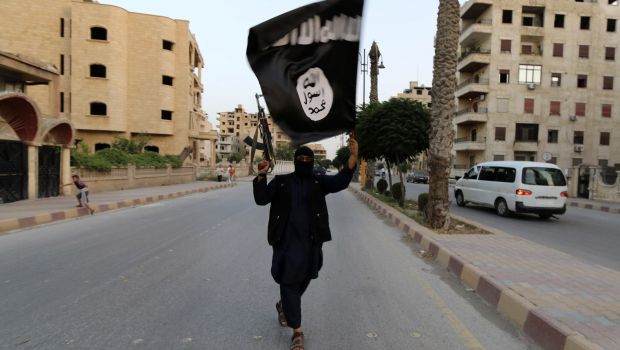The Islamic State of Iraq and Syria (ISIS) is a successor of the Islamic State of Iraq (ISI), which Abu Omar Al-Baghdadi (born Hamid Dawud al Zawi) established in 2006. In April 2010, Abu Omar Al-Baghdadi and ISI War Minister Abu Hamza Al-Muhajir were killed by US and Iraqi government forces, and less than a month later, Ibrahim Awwad Ibrahim Al-Badri Al-Samarrai—otherwise known as Abu Bakr Al-Baghdadi—was sworn into office as the “Emir” of ISI. When he decided to later enter Syria, he began by sending missionaries who revived a spirit of jihad and stirred enthusiasm for the fight against the regime of Syrian President Bashar Al-Assad. He also established ISI sleeper cells led by Abu Mohammad Al-Jawlani (Adnan Al-Hajj Ali) and Abu Abdel Aziz Al-Qatari (Mohamed Youssef Al-Filistini).
From that point on, ISI began fighting against the Syrian army, which became an armed revolution after the famous incident at Jisr Al-Shughour transformed a peaceful protest into an outright war. ISIS then chose to settle in eastern Syria, an area fortified and geographically similar to Mosul and Anbar in Iraq, which has helped it survive and hold on to territory.
As time passed, the presence of ISI Takfirist groups and their members became an important factor in the weakening of the Syrian army. At the start of 2012, a number of individuals defected in opposition to Assad’s rule, on both the Islamist and liberal sides, including Jawlani, who established the Al-Nusra Front. This encouraged Abu Bakr Al-Baghdadi to establish ISIS on April 8, 2013, in response to Jawlani’s newly formed group, and in defiance of Ayman Al-Zawahiri, the leader of Al-Qaeda.
Since then, ISIS and its supporters have been working on a number of interconnected strategic projects. First, they have sought to take control of the entire armed wing of the Syrian opposition, a precursor to the declaration of Baghdadi as a new “Caliph” last week. Second, the organization has sought to set up branches across the Muslim world, in an effort to emulate Osama Bin Laden’s Al-Qaeda.
In pursuit of these goals, the organization has attempted to become more-or-less self-financing by taking control of oil wells in eastern Syria. ISIS also seeks to control Syria’s grain stores, smuggle Syrian antiquities, trade in internationally prohibited weapons, extort through highway robbery, and collect ransoms from foreign journalists and private companies and businesspeople transporting petroleum products in Iraq and Syria.
In terms of its organization and military strategy, ISIS relies on a “Military Council” led by former army officers with field experience, who use simultaneous, coordinated attacks to divide and defeat opposing forces. Then there is the group’s own military organizational structure. ISIS divides its own forces in every state into two divisions: the first is an “Elite Vanguard Battalion” responsible for storming military barracks, security centers, villages, and cities; the second comprises local sleeper cells that are deployed when the elite division expels state security forces from their area. This second group is then able to hold onto and administer the captured territory.
This strategy has made ISIS one of the richest jihadist–Takfirist organizations in modern history and a destination for Arab and foreign fighters. This wealth and popularity enabled Abu Bakr Al-Baghdadi to make fundamental changes to the group’s organizational structure in early 2014, at the beginning of the fighting in Iraq’s Anbar province. Each governor was dubbed a “Vice-Baghdadi of the State” and was afforded broad powers to operate without having to refer back to Baghdadi for instructions. Baghdadi has also increasingly come to rely on former military and security officers whose worldviews chime with ISIS’s ideology. A growth in funding has also doubled both the number of fighters the group claims and the operations it can support.
After the fall of Mosul on June 10, Baghdadi borrowed strategies from the Taliban in Afghanistan in setting up a government and establishing his “Islamic State.” ISIS was thus able to strengthen its ability to control and hold Sunni areas. So far, Baghdadi has not imposed allegiance on Sunni tribes or religious or political figures and has not fought with Sunni factions in the region.
The strategy has yielded a range of results for ISIS, and it has achieved some successes on the ground. Many Sunni Iraqis have become convinced that ISIS is their “savior,” despite strong regional opposition to the organization; and Arab and foreign fighters hailing from nearly 21 countries in Africa, Asia and Europe have been drawn to the fight in Iraq, with many since leaving the country to also fight for ISIS in Syria. The organization’s success has boosted its public profile to heights unseen for a jihadist group since Osama Bin Laden and the “old” Al-Qaeda. ISIS has also been careful to publicly say it respects minorities in its Iraqi strongholds, and its successes have delivered a massive blow to the prestige and reputation of the Iraqi security forces.
The counterpoint to this article can be read here.

ISIS so called “sucess” was only possible by the help of traitors within the Iraqi society. These people will collaberate even with a devil to back stab a community in Iraq that they feel took all the pleasures that was out there when Saddam Hussain was in power. Your article has shades of appreciation for ISIS, the criminal gang who have murdered so many innocent people, it’s like praising a bank robber of his skills to get away leaving behind empty bank and dozens of dead bodies. At least now there is no confusion in Iraq who is in favor of a stable democratic country and help that process with all the flaws that it has to achive a muture state and who are a traitor.